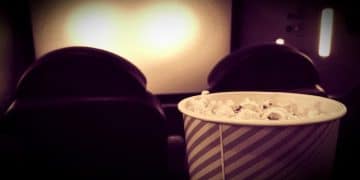The Chemistry Test: Analyzing Chemistry in 3 Romantic Movies
The Chemistry Test: Analyzing the On-Screen Relationships in 3 Romantic Movies delves into the essence of what makes cinematic couples believable, dissecting three iconic romantic films to reveal the secrets behind their compelling interactions and emotional resonance.
What makes a romantic movie truly unforgettable? Is it the sweeping soundtrack, the picturesque scenery, or something more intangible? The secret often lies in the on-screen chemistry between the lead actors. This article, titled The Chemistry Test: Analyzing the On-Screen Relationships in 3 Romantic Movies, will explore how that vital spark ignites – or fizzles – by examining three beloved films through the lens of interpersonal connection.
The Art of Believable Romance: Why On-Screen Chemistry Matters
On-screen chemistry isn’t just about actors looking good together; it’s about creating a believable and emotionally resonant connection that pulls the audience into the story. When actors lack chemistry, even the best script and direction can’t save a romantic film from feeling flat and unconvincing.
Defining On-Screen Chemistry
What exactly does it mean when we say two actors have “chemistry”? It’s that elusive spark, that unspoken understanding and mutual attraction that radiates from the screen. It manifests in subtle glances, playful banter, and a shared vulnerability that makes their characters feel real and relatable. This authenticity is key to drawing viewers in and making them emotionally invested in the characters’ journey.
The Impact of Casting Choices
Casting directors play a crucial role in fostering on-screen chemistry. They must not only find talented actors but also envision how those actors will interact with each other. Sometimes chemistry is evident from the audition process, while other times it requires careful pairing and rehearsal to cultivate. A good casting choice can elevate a film, while a poor one can sink it, regardless of individual talent.
- Good chemistry can lead to higher box office success.
- Authentic connections resonate with the audience.
- Poor chemistry can distract from the storyline.
- Casting choices are, therefore, crucial.
Ultimately, the success of a romantic film hinges on the audience’s belief in the central relationship. Without convincing on-screen chemistry, the love story falls flat, leaving viewers feeling detached and unfulfilled. That’s why understanding the dynamics of actor pairings is so important, allowing for a deeper appreciation of cinematic storytelling.

When Harry Met Sally: The Banter That Began It All
“When Harry Met Sally” is a masterclass in romantic comedy, largely due to the undeniable chemistry between Meg Ryan and Billy Crystal. Their characters’ evolving relationship, from contentious acquaintances to inseparable friends to eventual lovers, is fueled by sharp wit, playful banter, and a genuine affection that feels both authentic and endearing. The film explores the age-old question of whether men and women can truly be friends without romantic involvement, and the performances of Ryan and Crystal make the journey utterly believable.
The Power of Dialogue
The film’s dialogue is a key element in showcasing the chemistry between Harry and Sally. Their witty exchanges, often laced with sarcasm and playful jabs, reveal a deep understanding of each other’s personalities and insecurities. The dialogue feels natural and spontaneous, as if the actors are improvising, which further enhances the sense of genuine connection.
Evolution of the Relationship
What makes “When Harry Met Sally” so compelling is the gradual evolution of their relationship. We witness them navigating the complexities of friendship, attraction, and the fear of ruining a good thing. The actors masterfully portray the awkwardness, the longing, and the ultimate realization that they are meant to be together. This slow burn of love makes their final union all the more satisfying.
The undeniable magic of “When Harry Met Sally” lies in the exceptional chemistry between its leads, with their shared moments of vulnerability, laughter, and intellectual discourse showcasing the potential depth in authentic relationships, adding layers of warmth and genuineness to an already beautifully written story.
Before Sunrise: Intimacy in Every Conversation
Richard Linklater’s “Before Sunrise” is a unique entry in the romantic film canon, focusing almost entirely on the conversations between two strangers, Jesse (Ethan Hawke) and Celine (Julie Delpy), who meet on a train and decide to spend a day exploring Vienna together. The film’s success hinges on the ability of Hawke and Delpy to create a believable and engaging connection through their dialogue and interactions. They achieve this with remarkable ease, drawing the audience into their intimate and philosophical discussions about life, love, and everything in between.
Authenticity and Spontaneity
One of the reasons “Before Sunrise” feels so fresh and authentic is the improvisational nature of the performances. Linklater encouraged Hawke and Delpy to contribute to the dialogue and inject their own personalities into the characters. This collaborative approach resulted in a film that feels remarkably natural and spontaneous, as if we’re eavesdropping on a real conversation between two people.
Connection Through Vulnerability
Jesse and Celine connect through their willingness to be vulnerable and open with each other. They share their hopes, fears, and insecurities, creating a sense of intimacy that transcends their brief encounter. This vulnerability allows the audience to see beyond the surface and connect with the characters on a deeper emotional level. It highlights the importance of honesty and openness in forming meaningful relationships.
- Film relies entirely on dialogue-driven chemistry.
- Delpy and Hawke’s improvisation adds genuine feeling.
- Their characters connect through vulnerability and openness.
- The film is a testament to the power of conversation.
The intimacy between Hawke and Delpy in “Before Sunrise” stems from their sincere engagement with the script, injecting their own stories into the characters, which makes their on-screen chemistry feel less like acting and more like real human exchange, offering an unparalleled viewing experience.
La La Land: Dancing Through Joy and Heartache
Damien Chazelle’s “La La Land” is a visually stunning and emotionally resonant musical that explores the complexities of love, ambition, and sacrifice. The film’s central relationship between Mia (Emma Stone) and Sebastian (Ryan Gosling) is characterized by both joy and heartbreak, as they navigate their individual dreams and the challenges of building a life together in Hollywood. The chemistry between Stone and Gosling is crucial to the film’s success, as they must convey both the initial spark of attraction and the eventual pain of separation.
Shared Dreams and Aspirations
Mia and Sebastian’s connection is rooted in their shared dreams and aspirations. They both yearn for creative fulfillment and understand the sacrifices required to achieve their goals. This shared passion creates a bond between them, but also ultimately contributes to their downfall, as their individual ambitions pull them in different directions.
The Music Connection
The music in “La La Land” plays a significant role in showcasing the chemistry between Mia and Sebastian. Their duets and dance sequences are not just visually appealing; they also reveal the emotional depth of their relationship. The songs express their shared hopes, their fears, and their love for each other, creating a powerful and moving experience for the audience.
Challenges and Sacrifices
While Mia and Sebastian’s chemistry is undeniable, their relationship is also marked by challenges and sacrifices. They must constantly balance their love for each other with their individual ambitions, leading to difficult choices and painful compromises. This conflict adds depth and complexity to their relationship, making it all the more relatable and heartbreaking.
Ultimately, the story between Stone and Gosling in “La La Land” showcases that on-screen chemistry goes beyond physical attraction. It touches on shared vulnerabilities, authentic encouragement, and that sweet, yet bitter note of realism that love doesn’t always conquer all, but leaves a lasting mark nonetheless.
Comparing the Couples: What Works and Why
Each of the three films discussed offers a unique perspective on on-screen chemistry and romantic relationships. “When Harry Met Sally” showcases the power of witty banter and evolving friendship, “Before Sunrise” emphasizes the importance of vulnerability and open communication, and “La La Land” explores the complexities of love and ambition. By comparing these couples, we can gain a deeper understanding of what makes on-screen chemistry work and why certain relationships resonate so strongly with audiences.
Differing Approaches to Romance
The three films approach romance in different ways. “When Harry Met Sally” follows a more traditional romantic-comedy structure, with a clear progression from initial animosity to eventual love. “Before Sunrise” is more unconventional, focusing on a fleeting encounter and the potential for connection. “La La Land” blends elements of both, with a passionate romance that is ultimately tempered by reality.
The Role of Dialogue and Interaction
Dialogue and interaction are crucial in all three films, but their importance varies depending on the specific relationship. In “When Harry Met Sally,” the witty banter and verbal sparring are essential to showcasing the characters’ personalities and growing affection. In “Before Sunrise,” the intimate conversations are the heart of the film, revealing the characters’ inner thoughts and feelings. In “La La Land,” the music and dance sequences add another layer of communication, expressing emotions that words cannot convey.
While each film presents a unique take on romance, they all share a common thread: the importance of authenticity and genuine connection. When actors can create a believable and emotionally resonant relationship, the audience is more likely to invest in their story and feel the full impact of their journey.
The Lasting Impact of Authentic Chemistry
When on-screen chemistry works, it can elevate a film from good to unforgettable. The relationships feel real, the emotions are raw, and the audience is left with a lasting impression. Whether it’s the playful banter of Harry and Sally, the intimate conversations of Jesse and Celine, or the bittersweet love of Mia and Sebastian, authentic chemistry has the power to move us, inspire us, and remind us of the beauty and complexity of human connection.
Creating Memorable Moments
Iconic scenes, such as the fake orgasm scene in “When Harry Met Sally,” the record store scene in “Before Sunrise,” and the Griffith Observatory waltz in “La La Land,” are all made more memorable by the undeniable chemistry between the actors. These moments capture the essence of the relationships and leave a lasting impression on the audience.
The Legacy of Believable Pairings
The actors who create these believable pairings often become synonymous with their roles, and their on-screen chemistry becomes a benchmark for future romantic films. The legacy of pairings like Meg Ryan and Billy Crystal, Ethan Hawke and Julie Delpy, and Emma Stone and Ryan Gosling endures, reminding us of the power of authentic connection and the magic of cinema.
| Key Point | Brief Description |
|---|---|
| 🎬 Defining Chemistry | Elusive spark; unspoken understanding. |
| 💬 Harry & Sally | Witty banter evolves to romance. |
| 🌅 Before Sunrise | Intense connection through conversation. |
| 🎶 La La Land | Dreams tested; chemistry through song. |
FAQ
▼
On-screen chemistry is the believable connection between actors that engages viewers; it goes beyond physical appearance and delves into creating mutual tension, emotion and understanding.
▼
Casting significantly influences a movie, impacting plot fluidity and authenticity. Correct casting can enhance a plot while incorrect casting creates disbelief and distracts an audience.
▼
“When Harry Met Sally” is iconic because of its witty, realistic dialogue, its relatable exploration into friendships and romance, and the undeniable chemistry of the leads Meg Ryan and Billy Crystal.
▼
Its focus on realistic, dialogue-driven connection sets it apart from other movies that use traditional romantic tropes. The actors influence on their characters only add to the film’s appeal.
▼
In “La La Land,” music showcases chemistry between the two main actors through duets and dance sequences, demonstrating both intimacy and emotional depth that words sometimes cannot express.
Conclusion
Analyzing the on-screen relationships in “When Harry Met Sally,” “Before Sunrise,” and “La La Land” reveals the critical role that chemistry plays in the success of romantic movies. It’s the intangible spark between actors that elevates a film, making it both believable and emotionally resonant for audiences. By examining these films, we gain a deeper appreciation for the art of creating authentic connections and the lasting impact of believable pairings.





